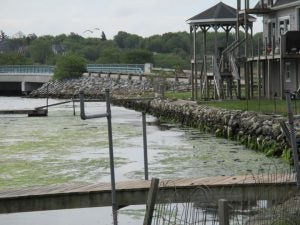Harmful Algal Blooms (HABs)
Would you like to help?
Coordinated monitoring programs (including URIWW staff and volunteers) document and help understand harmful cyanobacteria blooms. Check out cyanos.org to learn how you can get involved – including downloading the bloomWatch app.
2025 Activities and advisories:
The warm weather often brings HABs, especially in sites that regularly experience them. For a list of 2025 cyanobacteria monitoring activities by the RI Department of Environmental Management (RIDEM) see the Cyanobacteria (blue-green algae) dashboard – https://www.arcgis.com/apps/dashboards/d5780051f06f4c1b906bb692ccd7309a
Older advisories and other information from RIDEM can also be found at http://dem.ri.gov/bluegreen.
The bloomWatch data dashboard shows reports of blooms submitted by app users locally, nationally and even globally – click HERE to see recent reports.
Learn more about HABs:
- URI Watershed Watch’s Summary
- Interstate Technology and Regulatory Council: How to identify a HAB video
- Centers for Disease Control and Preventions: Harmful Algal Blooms (HABs)
- NALMS: Inland Harmful Algal Booms (HABs) Program
- NEIWPCC: Regional Cyanobacteria Workshops
- RI Department of Health:
- RI Department of Environmental Management: HABs
- USA EPA: Harmful Algal Blooms in Waterbodies
- USGS:
- CyanoCenterUBA (European Union)- Decision Support Tool
- University of New Hampshire Center for Freshwater Biology:
- VT Department of Health: Cyanobacteria
- Cyanosite (Purdue University): For Research on Cyanobacteria
- California Department of Public Health: Algal Blooms
- Minnesota Pollution Control Agency: Blue-green Algae and Harmful Algal blooms
- Causes, Effects and Management of ‘Blue Green Algae’ Cyanobacteria and their Harmful Algal Blooms in Australian Water: https://www.science20.com/causes_effects_and_management_of_blue_green_algae_cyanobacteria_and_their_harmful_algal_blooms_in_australian_water-139030
